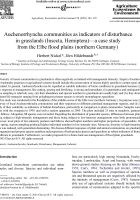Auchenorrhyncha communities as indicators of disturbance in grasslands (Insecta, Hemiptera) – a case study from the Elbe flood plains (northern Germany).
Nickel H., Hildebrandt J. 2003. Agriculture, Ecosystems and Environment 98: 183-199.

Abstract
Diversity of insect communities in grasslands is often negatively correlated with management intensity. Targets of sustainable husbandry practices in agricultural systems should include the conservation of insects highly specific to certain types of grassland. In general, Auchenorrhyncha can be regarded as suitable indicators of biotic conditions in grasslands because (i) their response to management, like cutting, grazing and fertilizing, is strong and immediate, (ii) quantitative and semiquantitative sampling is relatively easy, (iii) their abundance and species numbers in grasslands are usually high, and (iv) they show different life strategies ranging from polyphagous pioneer species to strictly monophagous specialists.
This study was conducted in the floodplains of the middle course of the Elbe river (northern Germany). Its purpose was (i)
a survey of local Auchenorrhyncha communities and their responses to different grassland management regimes, and (ii) a
study of their suitability as indicators of habitat disturbance, particularly in comparison to plant communities. Samples were
taken with the sweepnet in 1999, and with a suction apparatus in 2000. The plots included 25 sites in meadows, pastures
and fallows. Altogether, 88 species were recorded. Regarding the distribution of generalist species, differences between plots being subject to high-intensity management and those being subject to low-intensity management were little pronounced. However, most plots of low-intensity pastures and fallows showed higher numbers and higher proportions of specialists. In late spring, suction sampling produced higher individual numbers in low-intensity sites. Moreover, diversity in high-intensity sites was reduced, with generalists dominating.We discuss different responses of plant and animal communities on grassland management and propose species numbers and proportion of both pioneer species and specialists as robust indicators of biotic conditions in grasslands. Furthermore, we make proposals for a future land use management of flood plain grasslands.
Keywords
Auchenorrhyncha; Grasslands; Disturbance; Management; Indicator


